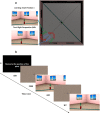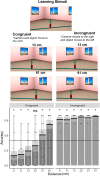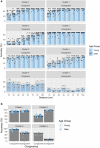Perspective taking and systematic biases in object location memory
- PMID: 33723725
- PMCID: PMC7959304
- DOI: 10.3758/s13414-021-02243-y
Perspective taking and systematic biases in object location memory
Abstract
The aim of the current study was to develop a novel task that allows for the quick assessment of spatial memory precision with minimal technical and training requirements. In this task, participants memorized the position of an object in a virtual room and then judged from a different perspective, whether the object has moved to the left or to the right. Results revealed that participants exhibited a systematic bias in their responses that we termed the reversed congruency effect. Specifically, they performed worse when the camera and the object moved in the same direction than when they moved in opposite directions. Notably, participants responded correctly in almost 100% of the incongruent trials, regardless of the distance by which the object was displaced. In Experiment 2, we showed that this effect cannot be explained by the movement of the object on the screen, but that it relates to the perspective shift and the movement of the object in the virtual world. We also showed that the presence of additional objects in the environment reduces the reversed congruency effect such that it no longer predicts performance. In Experiment 3, we showed that the reversed congruency effect is greater in older adults, suggesting that the quality of spatial memory and perspective-taking abilities are critical. Overall, our results suggest that this effect is driven by difficulties in the precise encoding of object locations in the environment and in understanding how perspective shifts affect the projected positions of the objects in the two-dimensional image.
Keywords: 3D perception: Space Perception; Spatial cognition; Spatial memory.
Conflict of interest statement
The authors declare that the research was conducted in the absence of any commercial or financial relationships that could be construed as a potential conflict of interest.
Figures






Similar articles
-
The role of memory and perspective shifts in systematic biases during object location estimation.Atten Percept Psychophys. 2022 May;84(4):1208-1219. doi: 10.3758/s13414-022-02445-y. Epub 2022 Feb 16. Atten Percept Psychophys. 2022. PMID: 35174468 Free PMC article.
-
Biases in object location estimation: The role of rotations and translation.Atten Percept Psychophys. 2023 Oct;85(7):2307-2320. doi: 10.3758/s13414-023-02716-2. Epub 2023 May 31. Atten Percept Psychophys. 2023. PMID: 37258895 Free PMC article.
-
An implicit spatial memory alignment effect.Cogn Process. 2015 Sep;16 Suppl 1:179-83. doi: 10.1007/s10339-015-0694-9. Cogn Process. 2015. PMID: 26233526
-
Age-related differences in visual encoding and response strategies contribute to spatial memory deficits.Mem Cognit. 2021 Feb;49(2):249-264. doi: 10.3758/s13421-020-01089-3. Mem Cognit. 2021. PMID: 32869141 Free PMC article.
-
Does visual working memory represent the predicted locations of future target objects? An event-related brain potential study.Brain Res. 2015 Nov 11;1626:258-66. doi: 10.1016/j.brainres.2014.10.011. Epub 2014 Oct 17. Brain Res. 2015. PMID: 25445999 Review.
Cited by
-
The role of memory and perspective shifts in systematic biases during object location estimation.Atten Percept Psychophys. 2022 May;84(4):1208-1219. doi: 10.3758/s13414-022-02445-y. Epub 2022 Feb 16. Atten Percept Psychophys. 2022. PMID: 35174468 Free PMC article.
-
Comparable performance on a spatial memory task in data collected in the lab and online.PLoS One. 2021 Nov 29;16(11):e0259367. doi: 10.1371/journal.pone.0259367. eCollection 2021. PLoS One. 2021. PMID: 34843521 Free PMC article.
-
Clockwise rotation of perspective view improves spatial recognition of complex environments in aging.Sci Rep. 2022 Nov 5;12(1):18756. doi: 10.1038/s41598-022-23301-x. Sci Rep. 2022. PMID: 36335225 Free PMC article.
References
-
- Aagten-Murphy, D., & Bays, P. M. (2019). Independent working memory resources for egocentric and allocentric spatial information. PLOS Computational Biology, 15(2), Article e1006563. https://doi.org/10.1371/journal.pcbi.1006563 - PMC - PubMed
MeSH terms
LinkOut - more resources
Full Text Sources
Other Literature Sources

